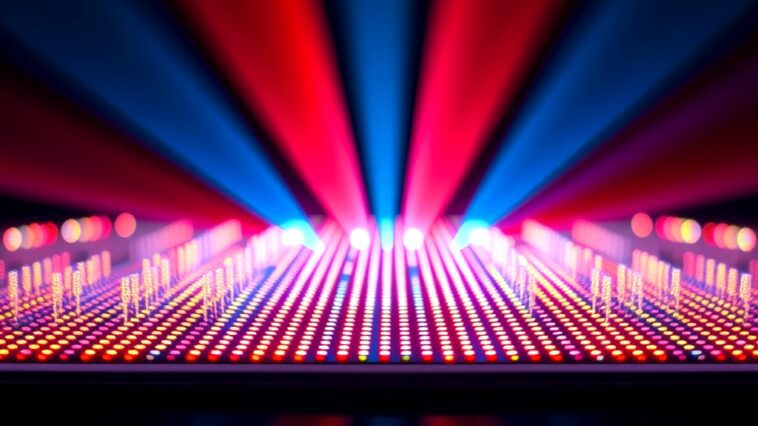Introduction
Have you ever wondered how those amazing screens on TVs, tablets, and smartphones work? Display technologies play a huge role in how we see pictures and videos every day. Two of the coolest new technologies that are shaking things up are Mini-LED and MicroLED. In this article, we’re going to break down what makes these two technologies special and how they are different from each other. Let’s dive in!
What is MicroLED?
Definition
MicroLED is a type of display technology that uses tiny LEDs (light-emitting diodes) to create images. Each of these tiny LEDs can produce its own light, which means MicroLED screens are “self-emissive.” This is a bit like how OLED (Organic Light Emitting Diode) works; both technologies make their own light instead of needing a backlight like traditional LCD screens.
Key Features
- Infinite Contrast Ratio: One of the best things about MicroLED is its ability to show true blacks. Since each tiny LED can turn off completely, there’s a perfect contrast between dark and bright areas of the picture. Imagine watching a movie with deep black shadows that look amazing!
- Lifespan: MicroLED displays don’t have the same problems as OLED screens when it comes to burning out or degrading over time. This means they can last longer and won’t show those annoying ghost images that sometimes happen on OLED screens.
- Brightness: MicroLED can get super bright! This means when you watch HDR (High Dynamic Range) content, the colors pop even more, and the bright areas of the image really shine.
- Modularity: One really cool feature of MicroLED is that you can make the screen any size you want. You can put together different panels to create a big screen for a home theater or a tiny screen for a smartwatch.
What is Mini-LED?
Definition
Mini-LED is a new and improved type of LCD technology. It uses smaller LEDs (hence the name “Mini-LED”) for backlighting the LCD screen. This is different from traditional LED backlights, which use larger LEDs. So, instead of just one big light behind the screen, Mini-LED has lots of tiny lights that can be controlled more precisely.
Key Features
- Higher Contrast Ratio: With Mini-LED, the contrast ratio is better than standard LCDs because the tiny LEDs can light up different areas of the screen more accurately. This means you’ll see better details in both dark and bright areas of the picture.
- Uniformity and Response Time: Mini-LED screens have a more even light distribution, which makes the colors look more consistent across the screen. They also have a quicker response time, which is great for fast-moving action in movies or games.
- Brightness: Mini-LED can produce brightness levels that are close to what you see on OLED screens. This makes it great for watching movies or playing games in bright rooms.
- Drawbacks: However, Mini-LED isn’t perfect. Sometimes, you might see a light bleed or halo effect around bright objects because of the way the zones are illuminated. This can be distracting if you’re watching something dark with bright objects.
Comparative Analysis
Similarities
Both Mini-LED and MicroLED are designed to make your viewing experience better. They’re both non-organic technologies, which means they don’t have the burn-in issues that OLED screens can have. This is a big plus for people who want their screens to last longer without any problems.
Differences
- Self-Emissive vs. Backlit: The biggest difference between the two is that MicroLED is self-emissive, while Mini-LED is a backlit technology. This means MicroLED can create its own light, while Mini-LED still needs a backlight.
- Performance: MicroLED usually has better contrast and brightness capabilities compared to Mini-LED. If you’re looking for the best viewing experience, MicroLED might be the way to go.
- Customization: MicroLED can be arranged in any shape or size, while Mini-LED is more limited to the screen size you buy. This means MicroLED offers more flexibility for unique displays.
- Target Markets: Currently, MicroLED is more of a futuristic technology that we’re starting to see at high-end brands, while Mini-LED is already being used in many consumer TVs and monitors. You might find Mini-LED screens in stores right now, but MicroLED is still on the way.
Conclusion
To sum it up, both Mini-LED and MicroLED are exciting technologies that improve how we see images on screens. MicroLED offers amazing contrast, brightness, and a long lifespan without burn-in issues, while Mini-LED enhances traditional LCD screens to deliver better performance than ever before.
As technology evolves, we can look forward to seeing more of both Mini-LED and MicroLED in the market. If you’re thinking about buying a new display, consider what you need most—do you want the best contrast and brightness, or are you looking for something that’s already available and still very good?
Other Related Articles
- Eizo Foris FS2331 Review
- How Much Power Does a 144Hz Monitor Use? A Deep Dive into Energy Consumption
- Should I Turn On HDR for Gaming? A Comprehensive Guide
- Is iPhone 16 Pro OLED the Best Display Yet?
- Understanding Panel Variance: What It Means for Your Monitor Purchase
- Can You Throw Computer Monitors in the Trash? The Ultimate Guide to Eco-Friendly Disposal
- Understanding VESA ClearMR: The Future of Motion Clarity in Displays
- 4K vs 1080p – Is UHD Worth The Upgrade?
- How To Choose The Right Gaming Monitor: A Comprehensive Guide
- IPS vs OLED Monitors for Color Accuracy: The Ultimate Showdown
- HDMI 2.1: The Future of Home Entertainment and Gaming
- How to Connect Heart Rate Monitor to PC?
- Curved vs Flat TV – Which Should You Choose? The Ultimate Showdown for 2025
- Can You Connect M-Audio Monitors to PC?
- Why Is My PC Showing the Same Display on Two Monitors?
- Why Are Computer Monitors More Expensive Than TVs?
- The Best Flicker-Free Monitors for Eye Care
- Monitors for Mac vs Windows PCs: The Ultimate Showdown
- 1920×1080 vs 2560×1440 – Which One Should I Choose?
- 99219444 Toshiba and Its Revolutionary Features for Tomorrow’s Tech Landscape
- OLED vs QD-OLED: The Showdown of Display Technologies
- What Is DisplayPort 2.1?
- What Is The Best Monitor Size For Gaming?
- 720p vs 1080p vs 1440p vs 4K vs 8K – Which Should I Choose?
- Is An HDR Gaming Monitor Worth It?
- Mini-LED vs MicroLED: What’s the Difference?
- Do Pawn Shops Take Computer Monitors?
- What LG Computer Monitor is as Good as the C3?
- Understanding Pixel Walk and Pixel Inversion
- Curved vs Flat Monitors for Work: Which One is Right for You?
- What Is The Soap Opera Effect?
- 4K vs 1440p Monitors for Video Editing: Which One Should You Choose?
- Do I Have to Attach a Hood to My BenQ Monitor?
- Can You Use Mac as a Monitor for PC?
- What Is G-SYNC And What Does It Do?
- Daz Studios Summoner G8 for the Visionary Artist
- Dell vs HP Monitors for Gaming
- Understanding IPS Technology: A Comprehensive Guide
- 27-Inch Monitors vs 32-Inch Monitors for Productivity
- Understanding Screen Resolution: Why It Matters for Your Displays
- How to Transport Computer Monitors?
- How to Dispose of Computer Monitors?
- What Is 4K Resolution And Is It Worth It?
- How to Pack Computer Monitor for Moving?
- What Is HDR For TVs And Is It Worth It?
- 1440p or 144Hz – Which Is Best For You?
- USB Type-C Explained – Everything You Need To Know
- Samsung’s Exciting Journey into Glasses-Free 3D Displays at Gamescom 2024
- I Have A Problem with My Samsung Odyssey G3 Monitor Setup
- Is A 144Hz Monitor Worth It? A Comprehensive Guide
- Understanding FALD Blooming and the Halo Effect: A Deep Dive
- What Does 144Hz Mean? Understanding Refresh Rates in Simple Terms
- Is an UltraWide Monitor the Right Choice for You?
- Active vs Passive 3D – What’s The Difference?
- Understanding Glare Control in Luminaires for Computer Users
- Why Does My Acer Monitor Keep Going Black?
- Understanding Motion Blur Reduction: A Gamer’s Guide
- How to Connect Studio Monitors to PC?
- Misleading Monitor Specifications You Should Look Out For
- QLED vs OLED – Which Is Best?
- Understanding VESA AdaptiveSync and MediaSync: The Future of Display Technology




